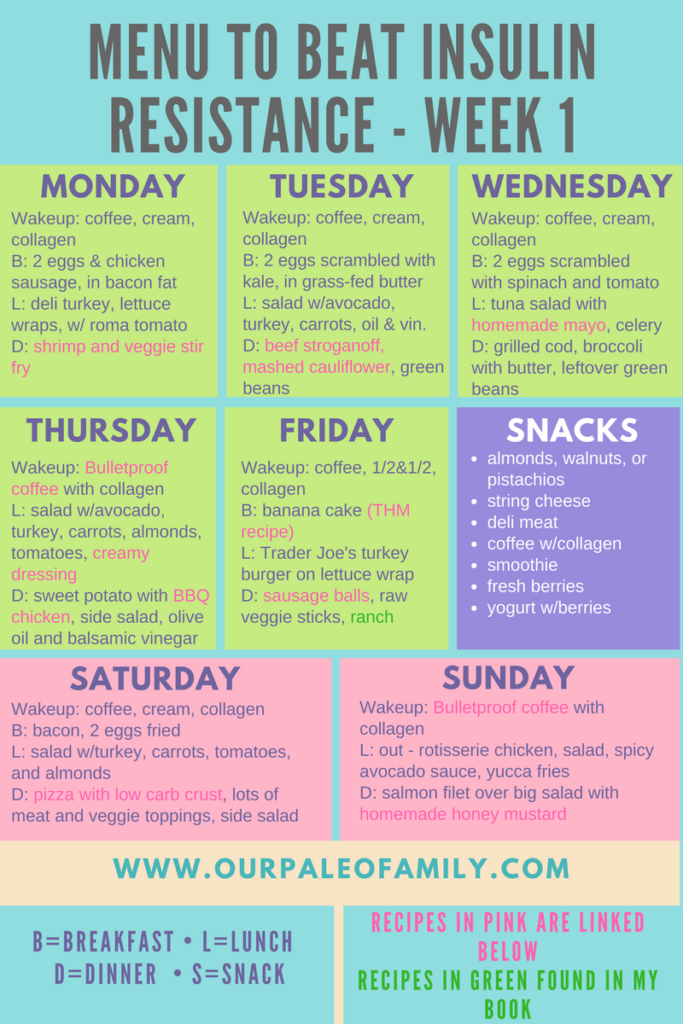Back in January of this year I told you that I was newly diagnosed with *almost* insulin resistance. You can read all the details about that revelation and my plans to beat it in these posts:
Am I on the Path to Insulin Resistance?
What is Insulin Resistance? Part 2 in the Series
What I’m doing about my *Almost* Insulin Resistance, Part 3 in the Series

My plan, as outlined in the first post, was to give you a part four in the series that would be full of menu ideas for how to stop this disease in its tracks. Then part five would reveal the results of my follow-up appointment. As I started to think about the diet information, I realized that it wouldn’t be wise to tell you how I was eating without knowing if my plan was doing any good.
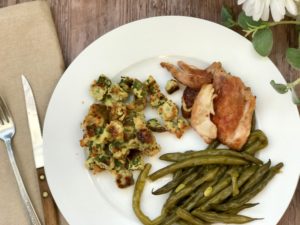
That’s why this article has been so delayed. Just a couple weeks ago I met with my functional medicine doctor to review my latest blood work. Part five of this series, where I will reveal the detailed results of my latest labs and outline where I go from here, is coming, bur first things first.
I can now safely say that the changes I made did indeed work. My insulin resistance (IR) score is down in the safe range – meaning I am not insulin resistant or even almost insulin resistant – so I can feel comfortable sharing with you how I’ve been eating.
In part 3 of my series I outlined all the supplements I’m currently taking and discussed my diet and exercise plan. Because I made multiple changes at one time, I can’t know for sure if the supplementation changes or the diet changes caused the improved lab results, but I can tell you this – in my opinion – the changes I made to my diet were more significant than the changes made to my supplementation regimen. Therefore, I feel safe in concluding that my diet was certainly helpful in moving that IR score downward.
If you simply want some printable meal plans, you can skip down to the PDFs below. I’ve prepared three 7 day meal plans with breakfast, lunch, dinner and snack ideas. But if you like more words, then read on. I’ll explain the method to my madness a bit. There might be a few rabbit trails and soap boxes. Just a warning.
In the previous articles in this series, I explained that my physician instructed me to consume between 100 and 150 grams of carbs per day, aiming for the higher number on intense workout days and the lower number on non-workout days. Honestly, whether I work out or not, most of my days are fairly active. If I don’t have time to do a concerted exercise routine, then that means I have a really hectic day going on and am probably burning more calories than I would if I had exercised. So, all that to say, I didn’t focus on grams of carbs as related to exercise. I treated all days the same and aimed for less than 100 grams of carbs each day.
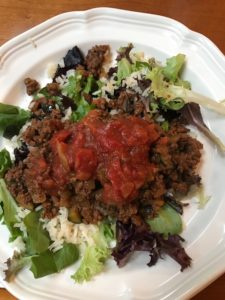
Since trying to incorporate the principles of the Trim Healthy Mama plan in an effort to lose a few pounds of fat, I was consuming on the upper end of that carb limit for a while – happily indulging in their E (energizing) meals. However, I have determined that I feel better, have more sustained energy, am hungry less often, and experience fewer dizzy spells, when I eat higher fat and lower carb – what is essentially a ketogenic diet.
After discussing my diet with my doctor, he suggested I purchase some ketone testing sticks to determine whether or not I’m in ketosis. Because I’m generally a very compliant person, I did purchase the keto-stix and surprisingly, I am not in ketosis. Conventional wisdom would suggest that I most certainly should be with my very low carb consumption (around 50 grams per day or less). I guess I’m just atypical. In more ways than one, but whose counting?
If you would like more information on ketosis, here is an article which provides some easy to understand information and a list of typical symptoms.
This is how I eat most days in general: primarily fat and protein, carbs only as treats or when I feel like my body needs it. How do I know if my body needs carbs? I’ve been tracking my food and how I feel for a very long time. Because I have Crohn’s disease, I’m very sensitive to any stomach upset or pain and I want to know immediately what I’ve eaten that might be causing the discomfort. I have been in remission for quite a few years now and I want to keep it that way. It can be a bit of a hassle to keep such a detailed food diary, but honestly, it’s become habit so isn’t a big deal most days and I’ve worked out a routine that works for me. Food journaling has many benefits. Here are a few of the primary ones from my perspective:
- you know exactly how your macros stack up each day (how much protein/carb/fat you’re consuming)
- you can look back over your notes when you get in a cooking rut and be reminded of meals everyone enjoyed
- a food journal forces you to plan your meals (if you do it the way I do it – see below)
- if something made you sick, it’s easier to pinpoint the culprit
I may do this a bit backward, but I complete my daily food journal first thing in the morning, writing down what I plan to eat that day. Then the following morning, while I still remember the day before, I note any deviations from my plan. So it’s really a plan and a journal all in one. That probably sounds strange, but it works for me. It’s convenient because I’m doing my journaling first thing in the morning during my Bible study time when it’s quiet, no one else is up and I can think clearly. If I had to stop what I was doing and write down what I was eating all throughout the day, I’m sure I wouldn’t do it very consistently. That was a long rabbit trail. Sorry.
I rarely eat fruit because it tastes so incredibly sweet to me. Plus, it’s really high in carbs (except for berries) and frankly, I much prefer one of my low carb treats made with stevia, which are much less sweet than traditional baked goods, like this key lime cheesecake. Yes, I know that a piece of fruit would have more nutritional value than a piece of pie, but I’m telling you what I do. Just being honest.
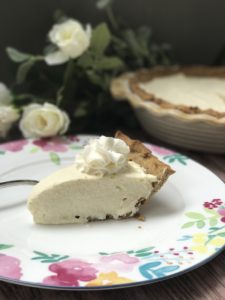
Of course, I am eating tons of vegetables as well, but they are generally very low in net carbs (total carbs – fiber = net carbs). For example, here are the carb counts for the vegetables I eat most often:
1 cup kale = 6.7 g (-1.3 g fiber = 5.4 net carbs)
1 cup leaf lettuce = 0.6 g (-0.3 g fiber = 0.3 g net carbs)
1 cup spinach = 1.1 g (-0.7 g fiber = 0.4 g net carbs)
1 cup zucchini = 4.2 g (-1.4 g fiber = 2.8 g net carbs)
1 cup asparagus = 7.4 g (-3.6 g fiber = 3.8 g net carbs)
1 cup cabbage = 10 g (-4 g fiber = 6 g net carbs)
1 cup mushrooms = 2.3 g (-0.7 g fiber = 1.6 g net carbs)
1/4 cup onions = 1.8 g (-0.4 g fiber = 1.4 g net carbs)
1 cup broccoli = 6.2 grams (-2.9 grams fiber = 3.3 net carbs)
1 cup cauliflower = 4.4 g (-2.3 g fiber = 2.1 g net carbs)
You can see that I can eat a lot of tasty, nutritious vegetables in a day and still keep to a very low carbohydrate intake.
A few notes on the printable meal plans below:
- I have coffee when I wake up in the morning and generally nothing else. I do add a splash of cream (about a teaspoon or less), a few drops of liquid stevia and 2 Tbsp. of collagen, which puts a little something in my stomach. I will exercise about an hour and a half after I get up and I don’t want anything heavy in my stomach during exercise.
- I eat when I get home from exercising and don’t always eat lunch (usually around 9:45). On the meal plans, I tried to give you a breakfast, lunch and dinner idea for each day, but on the days I didn’t, I gave an appropriately large dinner menu. This just represents real life. Somedays you may not have time for lunch. Or if, like me, you ate a late breakfast, you may not be hungry for lunch. Or you can make do with a couple snacks. We don’t all sit down to three squares a day so I tried to represent that in my menus.
- We eat mostly simple foods in my house. Lots of eggs, breakfast meats and greens for breakfast, salads or lettuce wraps for lunch, simple meat and veggies for dinner. It isn’t fancy or glamorous, but these are meals that my family actually eats and this is how I ate for four months to effectively knock insulin resistance out of town.
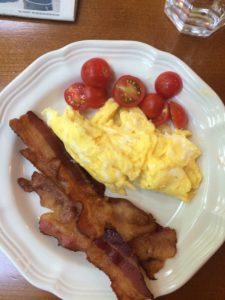
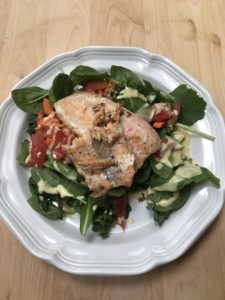
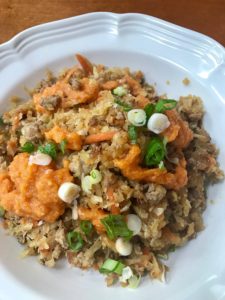
When I eat dessert, it’s usually a piece of quality dark chocolate or a piece of whatever low carb baked good I have lying around. I’ve been working on a coffee cake recipe so that’s what it’s been lately. Sometimes I’ll have some Halo or Enlightened brand ice cream. This isn’t the best, but it’s made with pretty pure ingredients, sweetened partly with stevia so it’s lower in sugar and makes a nice treat.
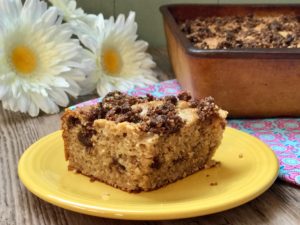
All through the day, I drink lots and lots of water with fresh lemon.
When I’m ready to unwind for the night, I’ll make a cup of lemon ginger tea (Yogi brand is my favorite) and mix in some apple cider vinegar and my vitamin c and generally another dose of collagen. I know some people swear by their glass of wine in the evening, but this tea is so soothing to me and is a great digestive, which is helpful since I had my gall bladder removed years ago. I find that if I have a little heartburn, some apple cider vinegar (diluted in water or tea) knocks it out in about an hour. Just an aside: I used to suffer heartburn frequently, but since following the paleo diet, it’s rare, but does happen on occasion.
One thing that has been particularly frustrating about this entire process is that I have not lost a pound. My weight fluctuates by about five pounds, but is never really headed lower. My BMI is in the normal range, but it should be lower and I know I should be leaner. I have wondered if my thyroid might be functioning improperly, but my thyroid labs always come back normal.
At my latest functional medicine visit, I was introduced to their newest gadget: a super high tech body scan torture machine. You know, the kind that tells you exactly how much fat you have and analyzes all your bad character traits? Ok, so that last part isn’t true. But it does tell you (in excruciating detail) just how much fat vs. muscle you have overall, in each leg, each arm, your abdomen (visceral fat – the dangerous kind that surrounds your internal organs), and your BMI. Unless you are a super lean body builder, you are probably not going to like what this machine tells you.
Following my scan, I met with the Health Coach who talked me through the results and made suggestions for change.
Here is where my struggle comes in. How much do I worry about this? Is it a vanity issue or is it a health issue? My fasting glucose and insulin results were not ideal one time, hence the insulin resistance talk. My lipoprotein profile is not good either and it hasn’t been for at least 15 years. BUT – my blood pressure is low, my Crohn’s disease is in complete remission, I just had a carotid artery scan and that test showed minimal “thickening” in a couple places. According to my functional medicine doctor everyone has plaque, even children, so I’m not at all worried about what showed on the carotid scan. My glucose and insulin labs are now normal. Perhaps most importantly, I feel good. I sleep well most of the time, I have a decent amount of energy and I have no digestive troubles at all. So do I worry about being 10 pounds over my ideal weight? Do I worry about having a less than ideal fat to muscle ratio in my legs? I don’t want to be retired and still worried about body composition. I lead an active life that includes exercise, playing with my kids, taking care of my house and yard and I do all that without trouble. Shouldn’t that be enough?
The bottom line for me is that I’m going to continue to eat well, exercise, generally make healthy decisions with these results and the advice of my health coach in mind, but I am not going to be deprived. And I am not going to stress over these body composition results. Do I wish it were different? Yes. Do I want to spend precious time trying to have the perfect body? No.
Some people don’t care anything about food. Shocking, isn’t it? That is something that I simply cannot imagine. I happen to like food. I like to make it and I like to eat it. It’s something that brings me joy. I enjoy cooking good food and ministering to others with that gift. I’m going to continue eating, mostly meats, vegetables and healthy fats, but treat foods will have a place in my diet. One day that treat might be ice cream and another day it might be french fries. I will make the best choices I can with those treat foods, like french fries made with real potatoes cooked in a healthy oil or ice cream made with cream, milk, eggs, real sugar and stevia. But I will have treats from time to time.
Unless I go to the doctor someday and they tell me that I am at high risk for a cardiac event, cancer, diabetes, etc. I’m going to continue as I am.
Finally, after many, many words, I present to you the meal plan to beat Insulin Resistance. Eating this way worked for me. During the four months between doctor visits, I ate little to no sugar. Not fruit, not sweet potatoes, not honey. Nothing. Only when I had to fulfill a cookie order did I have the tiniest bit just to taste and make sure everything was as it should be. As you’ll see in the meal plans, I did make space for the occasional treat entirely sweetened with stevia. I found that if I had something to look forward to, say a piece of that key lime cheesecake on Sunday, I could make it through the rest of the week.
Now that I know things are more back to normal, in terms of lab results anyway, I am slacking off a bit and allowing a few more treats here and there. But as I stated earlier, they are almost all ketogenic/paleo recipes that are very low carb and sweetened with stevia.
Here are some of my menus starting way back in January, right after I found out that my labs came back indicating that I was dangerously close (one point away) from being insulin resistant. I thought it would be most helpful to give you full day menus rather than a list of breakfast ideas, lunch ideas, dinner ideas, etc., because what you eat over the course of the day, or even the week, is really important. If you eat poorly for breakfast and lunch, don’t throw in the towel for dinner too. Even if you go away for a day and eat at restaurants for all your meals, make generally good choices, but also have a treat or two, that’s part of life. Savor it. Just get back to your healthy meals as soon as you can. I hope my weekly meal plans will illustrate this balance for you.
These are not just made up menus. These are really the foods my family and I ate while I was working very diligently to get my insulin resistance score down. The exception is that my family ate more carbs than I did. If I list a meal of BBQ chicken and green beans, they probably ate baked sweet potato or rice or fruit as well. Just assume the kids and my husband ate some healthy carbs with the meal. And they probably had dessert most nights as well. And they would eat it in front of me. The nerve.
Disclaimer: I am not a doctor, nor do I play one on TV. I am not a certified, bonafide medical professional in any sense of the word. What I’m sharing with you is based on information received from my actual, real life doctor, my own knowledge and good common sense. Please consult your real life doctor before making any major changes to your diet and/or lifestyle.
Below each printable graphic you will find links to the recipes within the meal plan. Most are my own recipes, but a few come from the Trim Healthy Mama cookbook and I obviously can’t give you those. I do recommend the book though. It is not paleo, but most all the recipes are gluten free and there are tons of them. You might have to tweak a bit to remove or limit dairy, but as a whole, it is a good cookbook, full of low sugar/low carb recipes and I’ve found it very helpful.
There are a couple recipes in the menus which are available in my ebook, Your Paleo Holiday, which you can purchase here. For the pie crust recipe used in the quiche, you can get it for free by signing up for my newsletter at this link.
Click on the arrow on the right hand corner of the menu for print and other options.
[pdfviewer]http://ourpaleofamily.com/wp-content/uploads/2017/05/Menus-to-Beat-Insulin-Resistance-WK1.pdf[/pdfviewer]
Asian Beef and Vegetable Stir Fry (just use shrimp instead of the beef) / Ground Beef Stroganoff (AIP) / Honestly, Really Delicious Mashed Cauliflower Potatoes / Homemade Mayonnaise / Instant Pot BBQ Chicken (Paleo, THM-E) / You can find the Banana Cake recipe in the THM cookbook / Primal Sausage Balls, Just Like You Remember / Sweet Potato Meatza (Primal, Paleo or AIP) (I made this without the sweet potato in the crust) / Creamy Balsamic Salad Dressing – for honey mustard, follow the same procedure as in this recipe and use mayonnaise, mustard and liquid stevia to taste
[pdfviewer]http://ourpaleofamily.com/wp-content/uploads/2017/05/Menus-to-Beat-Insulin-Resistance-WK2.pdf[/pdfviewer]
Bacon Mayonnaise (mash this with hard boiled eggs and cooked bacon to make bacon and egg salad) / Okra Fritters (variations for Paleo, Primal, AIP and THM-S) / No Frills Cole Slaw / Primal Cheeseburger Soup (Paleo and AIP options) / Paleo Meatloaf / Honestly, Really Delicious Mashed Cauliflower Potatoes / Key Lime Cheesecake (Primal or THM-S) / Fresh Strawberry Salad (the dressing in this recipe is a great example of a low sugar dressing)
[pdfviewer]http://ourpaleofamily.com/wp-content/uploads/2017/05/Menus-to-Beat-Insulin-Resistance-WK3.pdf[/pdfviewer]
You can find the THM pancake recipe in the THM Cookbook / Okra Fritters (variations for Paleo, Primal, AIP and THM-S) / Philly Cheesesteak in a Bowl (Primal, Keto, THM-S) / Turkey Meatballs (Paleo, AIP and Trim Healthy Mama E options) / Primal or Paleo Version of Trim Healthy Mama Cheeseburger Pie / Pork and Veggie Un-Rolls / Cinnamon Streusel Coffee Cake / Baked Chicken Thighs with Citrus Glaze / Paleo Meatloaf / Honestly, Really Delicious Mashed Cauliflower Potatoes / Brussels Sprouts with Bacon and Onion Jam
